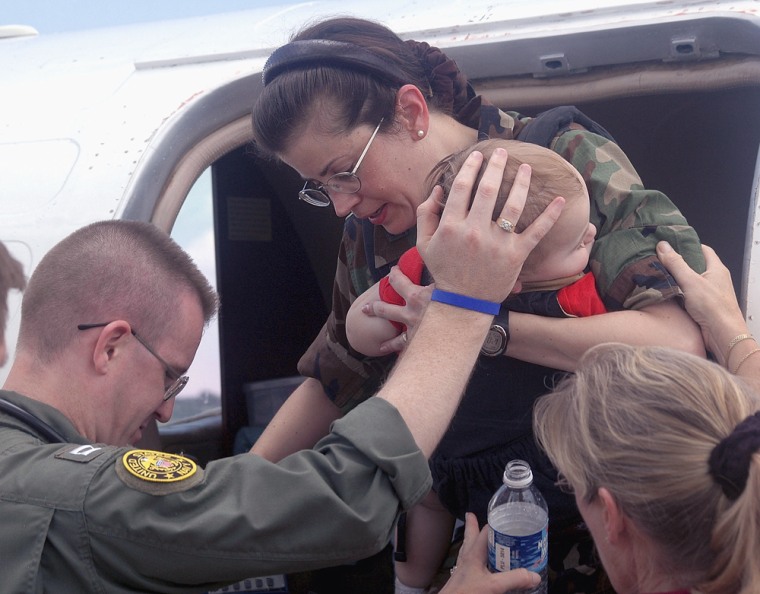The U.S. Air Force will send 300 airmen home from Iraq and Afghanistan to help their families cope with emergencies on a hurricane-devastated airbase in Biloxi, Miss., a spokesman said Saturday.
The airmen, all based at Keesler Air Force Base, would begin flying home over the next two weeks, said Air Force Capt. David Small, spokesman for U.S. Central Command Air Forces in Qatar.
The group includes airmen who were scheduled to rotate home in September and others whose deployments would be cut short.
“Those who weren’t scheduled to go home, we’re going to send them home anyway to take care of their families and the hurricane damage,” Small said.
In addition, the Air Force said nearly 100 airmen who were due to deploy from Keesler to Iraq and Afghanistan will remain at the base, with their positions overseas filled by others not affected by the hurricane.
Direct hit
Keesler, just off the beach in the Gulf Coast city of Biloxi, suffered a direct hit from Hurricane Katrina. The storm wiped out much of its housing and other infrastructure. Small said most personnel and families on the base had been moved to temporary shelters.
“Everything was under water,” he said.
Master Sgt. James Riley, 39, said he left Keesler only six days ago for duty on the U.S.-run al-Udeid Air Base in Qatar. Now, Riley is finishing his paperwork to return to Mississippi.
“I’ve been called back to assist with recovery efforts and to assist my family,” said Riley, whose wife and three children have taken shelter in a school on the base.
U.S. authorities want Keesler returned to operation to handle hurricane relief flights, Riley told The Associated Press.
“It’s going to be the heart, the pulse of the relief effort,” Riley said. “We’ve got a vested interest in getting back there and getting things running. That’s where our homes are, that’s where our families are.”
The storm wiped out 90 percent of the homes on the base, with officers’ quarters — closest to the waterfront — faring worst, Riley said.
Decision made by top officials
Small said he had heard no reports of storm-related deaths on the base. Keesler houses both active-duty airmen and Air Force Reservists.
The decision to send Keesler-based airmen home was made by top Air Force officials with the support of Brig. Gen. Allen G. Peck, the deputy commander of coalition air forces in the Iraq and Afghanistan theaters. Peck is based at al-Udeid Air Base in Qatar.
Small said the 300 airmen will be leaving many bases in Iraq and Afghanistan as well as surrounding countries in Central Asia and Arab states of the Persian Gulf. Some will be flying home on commercial airlines, he said.
Small said the Air Force would make sure that the early departure would not damage the Air Force’s warfighting capabilities, which include ground-attack sorties, cargo and fuel deliveries, air-to-air refueling and troop transport.
“We’re making sure the unit commanders here can still conduct their missions without the folks from Keesler,” Small said. “There are about 18,000 airmen in the theater, so we can pick up the slack.”
Keesler's usual role
A statement on Keesler’s Web site described damage to the base as “severe enough that we are unable to leave our shelters until Thursday at the earliest.” Base residents were waiting for recovery teams to clear debris and repair damage before Keesler would be reopened.
Air Force personnel serve shorter, more frequent deployments in the war theaters than do U.S. Army and Marine forces. Air Force deployments average about four months — but can extend to a year, Small said. By contrast, Army deployments last from 10 months to a year, and Marines are sent for about seven months.
Keesler houses the U.S. Department of Defense’s weather school, the Air Force’s second-largest medical facility, and handles training in high-tech command-and-control and computer networking.
No large-scale shift
U.S. military officials have said there are no plans for a large-scale shifting of U.S. troops from Afghanistan or Iraq to assist recovery efforts.
The commander of the Louisiana National Guard’s 256th Brigade Combat Team, based in Baghdad, had asked that his 3,700 soldiers be sent home early to deal with the crisis. The 256th already was preparing to go home later this month when Katrina struck. The Army said the brigade would be brought home a week earlier than planned, with arrival due Tuesday.
However, in general, only U.S. troops whose family members were injured or killed by the hurricane may be allowed to go home early, Lt. Gen. John Vines, commander of Multi-National Corps-Iraq, said Friday. Others will have to stay in Iraq and finish their missions, he said, otherwise remaining troops in Iraq would be at greater risk.
Emergency leave is being handled on a case-by-case basis, said Lt. Col. Steve Boylan, a spokesman for the U.S. command in Baghdad.
“We are not redeploying units/personnel for the hurricane relief efforts as all the units/personnel here are required for the ongoing security and stability operations happening here in Iraq,” Boylan said in an e-mail message.
